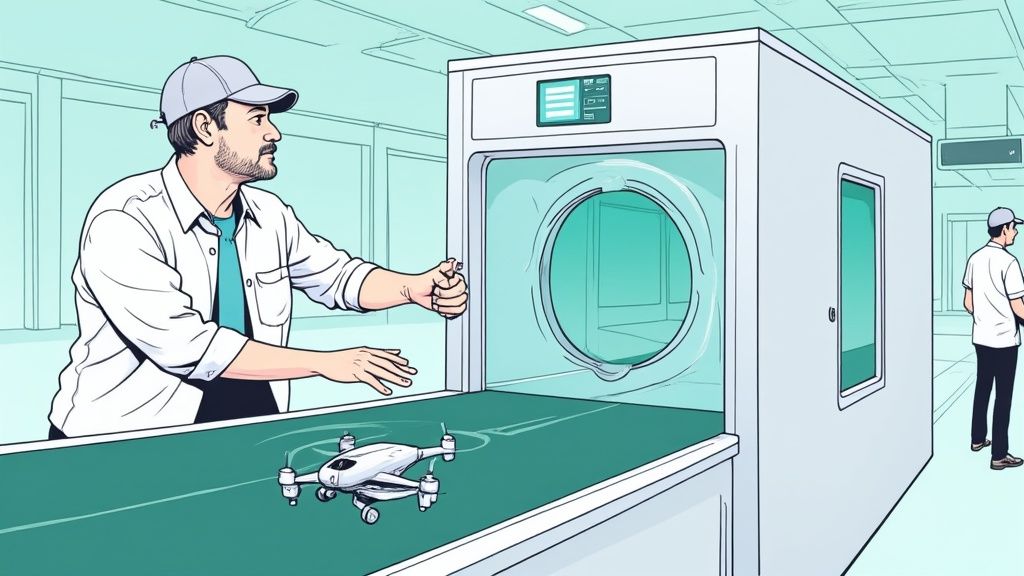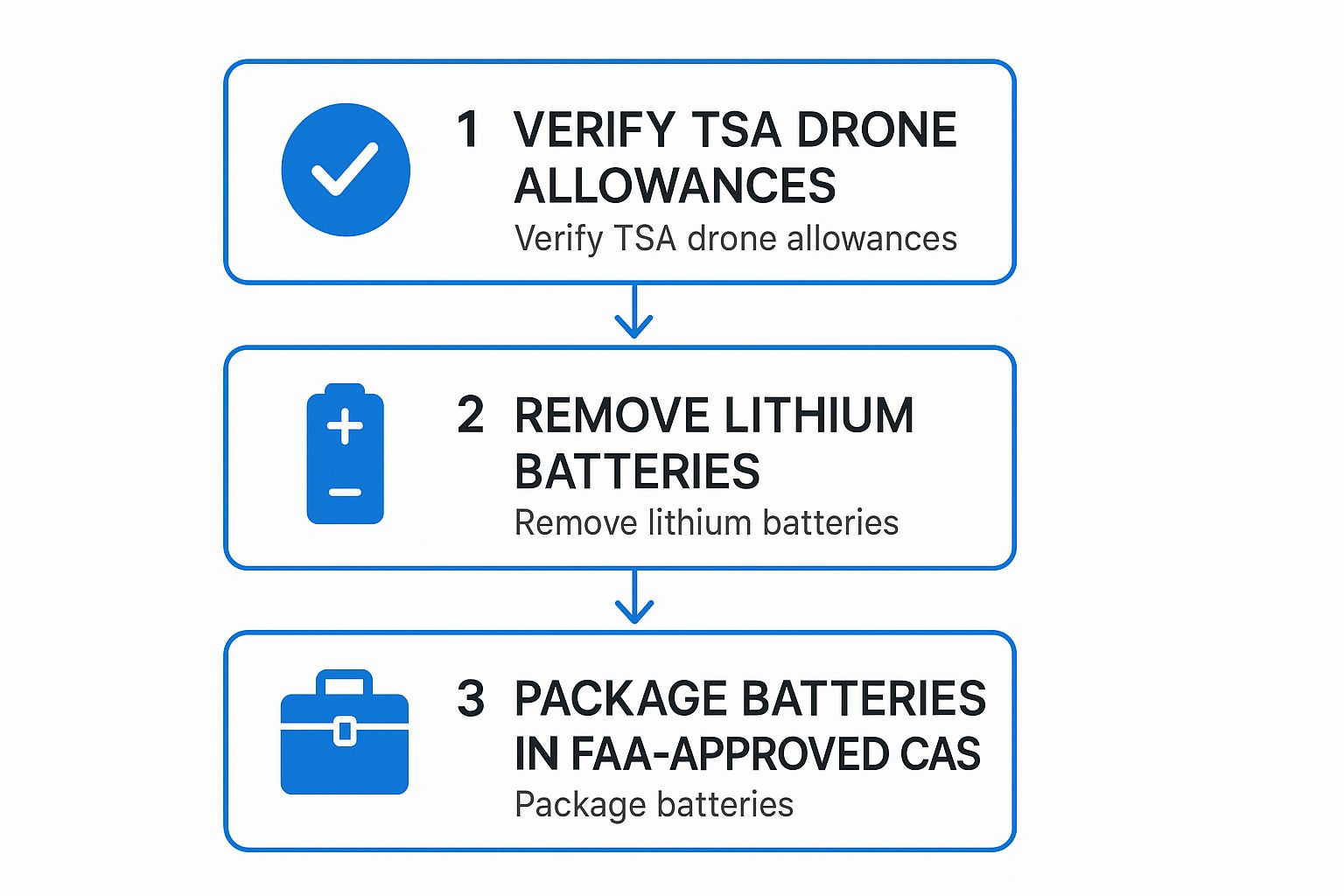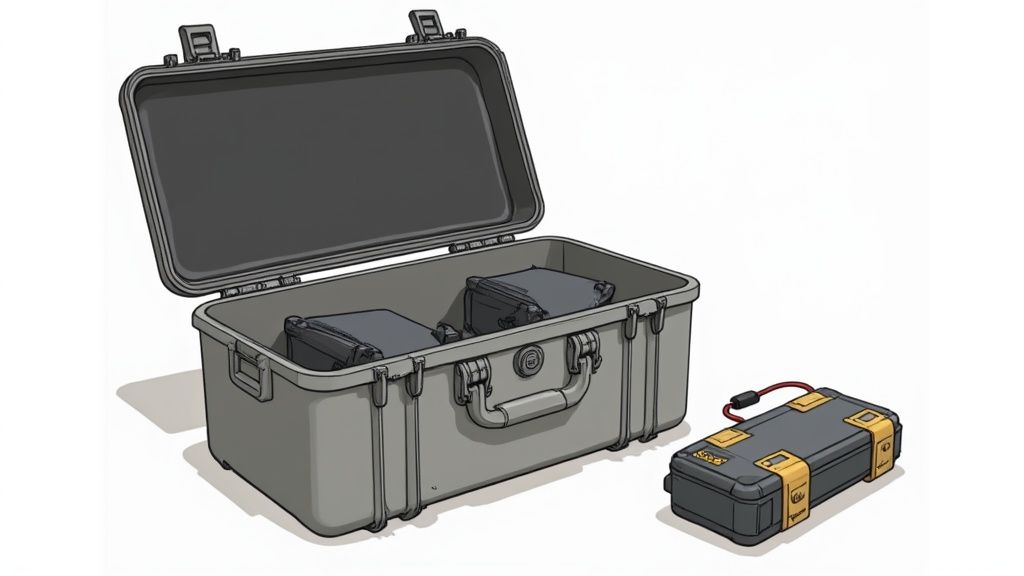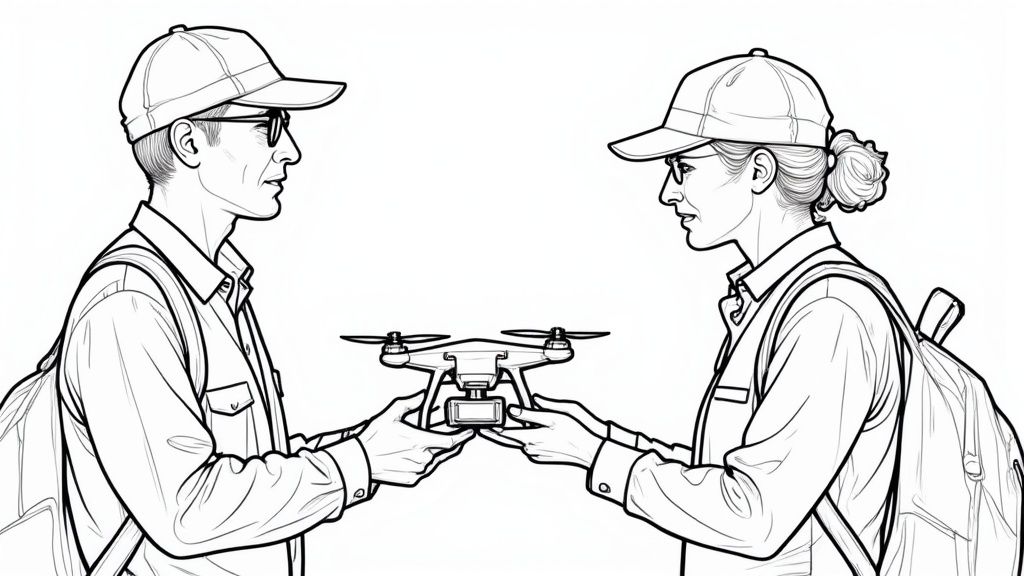Can I Bring a Drone on a Plane in 2024
- Jab Media

- Sep 12
- 13 min read
Updated: Sep 14
Yes, you absolutely can bring your drone on a plane. I've done it dozens of times. The key thing to understand is that the rules aren't really about the drone itself—they're all about the powerful lithium-ion batteries that power it.
Your drone can technically ride in either your carry-on or your checked luggage. But here’s the golden rule: all spare batteries *must* be in your carry-on bag. No exceptions.
Flying With a Drone: The Basics You Need to Know
Planning to get some epic aerial shots on your next vacation? Good news—flying with your drone is pretty straightforward once you get the hang of it. The Transportation Security Administration (TSA) and the Federal Aviation Administration (FAA) have laid out clear guidelines to keep everyone safe, and they're simpler than you might think.
The number one concern for airport security is the potential fire risk from lithium-ion batteries. Think about it: if a battery decides to act up in the cargo hold, it's a huge problem that's hard to get to. But if something happens in the cabin, the flight crew is right there and trained to handle it immediately.
That’s the single most important reason why all your drone batteries have to fly in the cabin with you.
Don't just take my word for it. Here’s the official guidance straight from the TSA's "What Can I Bring?" tool, which confirms drones are allowed in both carry-on and checked bags.

As you can see, even the TSA suggests putting the drone in your carry-on if possible. It’s not just about rules; it’s about protecting your gear from the notoriously rough handling of checked luggage. But notice that critical line about the batteries—they have to be carried on.
Packing Your Drone Kit: A Quick Guide
To make packing a breeze and get you through security without a hitch, here's a simple breakdown of where everything should go. Sticking to this will save you a lot of headaches.
I've put together a quick reference table to make it even easier.
Drone Carry-On vs Checked Luggage Quick Guide
This simple chart covers the essentials. The main takeaway is to keep your most valuable and volatile components with you in the cabin.
Here's a little more detail on how to pack it all:
The Drone Itself: You can pack it in either your carry-on or checked bag. Honestly, carry-on is always the smarter choice to avoid damage. I’ve heard too many horror stories about cracked gimbals and broken arms from checked bags.
Spare Batteries: These must be in your carry-on. Never, ever put loose lithium batteries in your checked luggage.
Controller, Props, and Cables: These can go in either bag, but it just makes sense to keep your whole kit together.
In the United States, FAA regulations are incredibly strict about lithium batteries because of fire safety. If you're curious about the why, learning more about the increasing risks posed to airliners really puts these rules into perspective.
For an even deeper dive with more pro tips, check out our complete pilot's guide on taking a drone on a plane.
Navigating TSA and FAA Drone Regulations
So, you want to bring a drone on a plane. The big question isn't just if you can, but how. This brings two major players into the picture: the Transportation Security Administration (TSA) and the Federal Aviation Administration (FAA).
Think of them like this: the TSA is all about the physical security check at the airport, while the FAA is laser-focused on the safe transport of potentially hazardous materials. And in the world of drones, "hazardous materials" means one thing: your lithium-ion batteries.
Let's walk through what you can expect from both.
The TSA Security Screening Experience
Treat your drone like you would a laptop or any other large electronic device. When you get to the security checkpoint, you’ll need to pull it out of your carry-on bag and place it in its own bin for the X-ray scanner. This gives the TSA officers a clean look at all its internal parts.
My pro tip? Pack your drone right at the top of your bag. It makes the whole process faster and keeps you from holding up the line.
TSA agents see drones constantly, so it’s usually a non-event. They might ask a few quick questions, but what they’re really checking for is that your batteries are packed correctly according to FAA rules. As long as you’ve followed the guidelines, you’ll be through in no time.
This quick visual guide breaks down the essential steps for a smooth security screening.

It really boils down to three simple things: know the rules, handle your batteries with care, and pack everything safely before you leave for the airport.
Understanding FAA Battery Rules
This is the part you absolutely cannot ignore. The FAA has strict, non-negotiable rules for lithium-ion batteries because of their potential fire risk.
Here’s the most important takeaway: all spare batteries must be in your carry-on luggage. No exceptions. You can leave one battery inside your drone (even if the drone is in a checked bag), but it has to be powered down completely and secured so it can't turn on accidentally.
The rules are all based on a battery's power, which is measured in Watt-hours (Wh).
Batteries under 100 Wh: Good news! Most consumer drone batteries, like the ones for the DJI Mavic or Mini series, fall into this category. You can bring as many as you reasonably need for personal use, as long as they are in your carry-on.
Batteries from 101-160 Wh: This is where you’ll find batteries for larger, professional-grade drones. For these, you are limited to carrying two spare batteries, and you must get approval from the airline before you fly.
"Airline approval" isn't complicated, but it's not something you want to handle at the check-in counter. It just means you need to call the airline's customer service a few days before your trip and let them know you'll be traveling with these larger batteries.
Any battery over 160 Wh is completely forbidden on passenger planes. Don't even try it.
How to Calculate Watt-Hours
What if your battery doesn't list the Watt-hour rating? No problem. You can figure it out yourself with a quick calculation. Just find the volts (V) and amp-hours (Ah) on the battery label and multiply them.
Formula: Volts (V) x Amp-hours (Ah) = Watt-hours (Wh)
For instance, a 15.4V battery with a 3.85Ah (or 3850mAh) rating comes out to 59.29 Wh—safely under that 100 Wh limit. Knowing how to do this simple math can save you a world of headache at the airport.
Of course, these FAA rules are just for flying within the U.S. If you're heading abroad, you'll have a whole new set of local laws to navigate at your destination. To get a handle on that, you might want to read this comprehensive guide to drone regulations in every country.
Mastering Drone Battery Safety for Air Travel

Knowing the FAA’s battery rules is one thing, but safely packing them is where the rubber meets the road. These regulations aren't just red tape; they're designed to prevent a rare but incredibly dangerous event called thermal runaway.
This is when a damaged lithium-ion battery overheats and catches fire. It's precisely why all your spare batteries must go in your carry-on, where any issue can be spotted and handled immediately.
Your main job here is simple: prevent a short circuit. This can happen if the metal battery terminals touch another conductive object in your bag—think keys, coins, or even another battery. That contact completes a circuit, causing the battery to discharge rapidly, overheat, and potentially ignite.
Protecting Your Batteries from Short Circuits
Thankfully, securing your batteries is easy and only takes a minute. You’ve got a few solid options to keep them safe and stay on the right side of the FAA.
The quickest and most common method is using good old electrical tape. Just tear off a small piece and cover the metal contact points on each battery. This creates a non-conductive barrier, making a short circuit impossible. It’s a cheap, effective fix that security agents recognize instantly.
Your other go-to options involve isolating each battery individually.
LiPo-Safe Bags: These fire-resistant pouches are the gold standard. They're designed to contain a fire if a battery ever fails, giving you and the flight crew critical time to react.
Original Packaging: If you hung onto the box your battery came in, its plastic molding is perfectly shaped to protect the terminals.
Plastic Bags: In a pinch, even putting each battery in its own separate plastic bag will work. The goal is simply to keep the terminals from touching anything else.
The objective is straightforward: isolate the terminals. Whether you use tape, a dedicated LiPo bag, or its original case, the key is to ensure those metal contacts can't touch anything conductive.
If you really want to get into the weeds of battery care, our comprehensive LiPo battery safety guide offers essential tips that actually work. It's a fantastic resource for any serious pilot.
Never Fly with a Damaged Battery
Before you even think about packing, give every single battery a quick once-over. You're looking for any red flags that signal internal damage. A compromised battery is a massive safety risk. If you spot any of the signs below, leave that battery at home. Period.
Warning Signs of a Damaged Drone Battery
Trying to fly with a damaged battery just isn't worth it. When you ask, "can I bring a drone on a plane," the answer is a resounding yes—but only if you prioritize the safety of your gear, the crew, and every other passenger on board. A few simple precautions make all the difference.
Decoding Individual Airline Drone Policies

So, you've successfully navigated the TSA and FAA rules. That's a huge step, but it only gets you as far as the check-in counter. The final gatekeeper for your drone is the airline you're actually flying with.
It's best to think of the federal regulations as the bare minimum. Individual airlines have every right to impose their own, often stricter, policies.
This is a step I see far too many travelers skip, and it can cause some serious last-minute headaches. An airline’s specific rules can be the difference between a smooth trip and a frantic scramble to repack your expensive gear right there in the terminal. The good news is most major airlines stick pretty close to the FAA's script, but you should never, ever assume.
Before every single flight, you need to check your airline's policy. It's a small bit of homework that pays off with massive peace of mind.
How to Find Airline-Specific Drone Rules
Airlines don't exactly roll out the red carpet with a dedicated "drone policy" page. Instead, the info you need is usually tucked away in their guidelines for restricted items or hazardous materials, specifically focusing on—you guessed it—lithium-ion batteries.
To hunt down the right information, head to your airline's website and search for a few key terms:
"Restricted items"
"Prohibited items"
"Lithium batteries"
"Portable electronic devices"
These searches will almost always lead you to the pages that detail their rules on battery sizes (in Watt-hours), how many you can bring, and specific packing instructions. This is where you’ll find out if they have any special requirements that go beyond the standard FAA regulations.
Pro Tip: Once you find the official policy on the airline's website, take a screenshot or print it out. If you happen to run into an airline employee who isn't up to speed on the rules, having their own policy ready to show can clear things up quickly and politely.
Wading through the legal language airlines use can feel like a chore, but it’s absolutely essential for a stress-free journey. If you want to get a better handle on how these rules come to be, our guide on decoding FAA legal interpretations offers some great background.
Comparing Major Airline Policies
Policies can—and do—differ, particularly when you start looking at domestic versus international carriers. One airline might be totally fine with your drone in a checked bag (with the batteries removed, of course), while another might strongly recommend or even require it to stay with you in your carry-on.
To show you how these subtle but crucial differences play out, I've put together a quick comparison of what you can expect from some of the major U.S. airlines.
Major Airline Drone Policy Comparison
While these top carriers have similar policies, don't let that lull you into a false sense of security. Budget airlines or international carriers often have their own unique quirks and rules. The only way to be 100% certain you can bring a drone on a plane without any drama is to verify the policy for your specific flight, every single time.
Flying Internationally With Your Drone
Taking your drone on an international trip unlocks some seriously incredible creative potential, but it also adds a critical layer of research to your travel prep. Getting your drone on the plane is only half the battle. You also have to make sure you can legally fly it when you land.
Every single country has its own unique set of rules, and trust me, "I didn't know" won't get you very far with customs officials. Your pre-flight checklist has to go way beyond battery safety and include a deep dive into your destination’s local drone regulations. A quick search for the country’s civil aviation authority website is always the best place to start. What you find there will tell you if bringing your drone is even worth the hassle.
Researching Local Drone Laws
Before you even think about packing that drone case, you need clear answers to several key questions about where you're headed. Skipping this step can lead to hefty fines or, in the worst-case scenario, having your expensive gear confiscated right at the airport.
Dig around for specifics on these points:
Registration Requirements: Do you have to register your drone with the local authorities, even if you're just a tourist?
No-Fly Zones: Are there strict restrictions around airports, government buildings, national parks, or historical sites? These are common but vary wildly.
Pilot Licensing: Does the country require foreign pilots to get a local permit or license to fly?
Insurance Mandates: Is proof of liability insurance required to operate your drone legally?
These rules can be night-and-day different from one country to the next. Some have a simple online registration process for foreign pilots, while others might ban drone use entirely in certain regions or for non-citizens.
Navigating international regulations really comes down to doing your homework. A country's drone laws are a reflection of its own security and privacy concerns, so never assume the rules you know from home will apply abroad. Showing up prepared is the only way to guarantee a smooth, legal, and fun flying experience.
Understanding Regional Regulations Like EASA
In some parts of the world, you'll find that regulations are harmonized across multiple countries, which can make life a lot easier. The European Union is the perfect example of this. The European Union Aviation Safety Agency (EASA) manages drone regulations across all EU member states, which means there are consistent rules for things like registration, pilot certification, and where you can fly.
This streamlined approach definitely simplifies cross-border drone trips within Europe. But you still have to comply with both your airline's policies and these host country laws to stay out of trouble. You can explore detailed 2025 drone laws to get a better sense of how these regulations are structured.
Even with regional oversight from an agency like EASA, it's always smart to double-check for any country-specific nuances that might exist.
One last tip: consider purchasing travel insurance that specifically covers your drone. This gives you a valuable safety net against theft, damage, or loss, offering some much-needed peace of mind while you're out there capturing amazing content far from home.
Your Top Drone Travel Questions Answered
Even after you've memorized all the rules, a few nagging questions always seem to pop up the night before a flight. We get it. Let’s tackle some of the most common, real-world scenarios you’re likely to face so you can pack with total confidence.
Do I Need to Declare My Drone at Check-In?
Nope, you don’t have to make a big announcement at the check-in counter. Your main focus should be preparing for the security line.
TSA officers will almost certainly ask you to take the drone out of your bag for a separate X-ray scan, just like a laptop. To make this as painless as possible, pack your drone right at the top of your carry-on for easy access.
It’s also a great idea to have your drone registration documents handy. While agents probably won’t ask to see them, the FAA requires you to have proof of registration with you anytime you fly a drone over 250 grams (0.55 lbs). Keeping both a digital and a paper copy is the smartest way to go.
Can I Bring a Large Professional Drone on a Plane?
You absolutely can, but it takes a lot more prep work. While the fundamental battery rules are the same, big professional drones often use beefy batteries that fly past the standard 100 Wh limit.
For these larger batteries between 101-160 Wh, you're capped at carrying two spares, and you must get approval from the airline beforehand. Anything over 160 Wh is pretty much a non-starter for passenger aircraft.
There's also the physical size to consider. Your drone's protective case will likely be too big for the overhead bin, meaning you'll have to check the drone body itself while keeping every single battery with you in the cabin. The key here is to call your airline well in advance to walk through their exact procedures for this kind of gear.
What Happens if My Drone Gets Damaged in Checked Luggage?
This is the nightmare scenario for any pilot, and for good reason. Airlines have very limited liability for damaged checked bags, and the payout you might get won't come close to the cost of a new drone. This is precisely why we always say: carry it on if you can.
If checking it is your only option, you absolutely need a top-tier, hard-shell case with custom foam inserts. Don't skimp here.
On top of that, seriously look into getting extra travel insurance that specifically covers electronics. Standard airline liability won't cut it if your expensive rig gets crushed. Protecting your investment with a dedicated policy is a non-negotiable for any traveling content creator or professional pilot.
Ultimately, getting your drone safely to your destination is on you. The answer to "can I bring a drone on a plane?" is yes, but making sure it arrives in one piece takes smart planning.
At JAB Drone, we're dedicated to helping pilots fly safely and confidently, wherever their travels take them. For more expert guides, reviews, and insights into the world of drones, visit us at https://www.jabdrone.com.




Comments